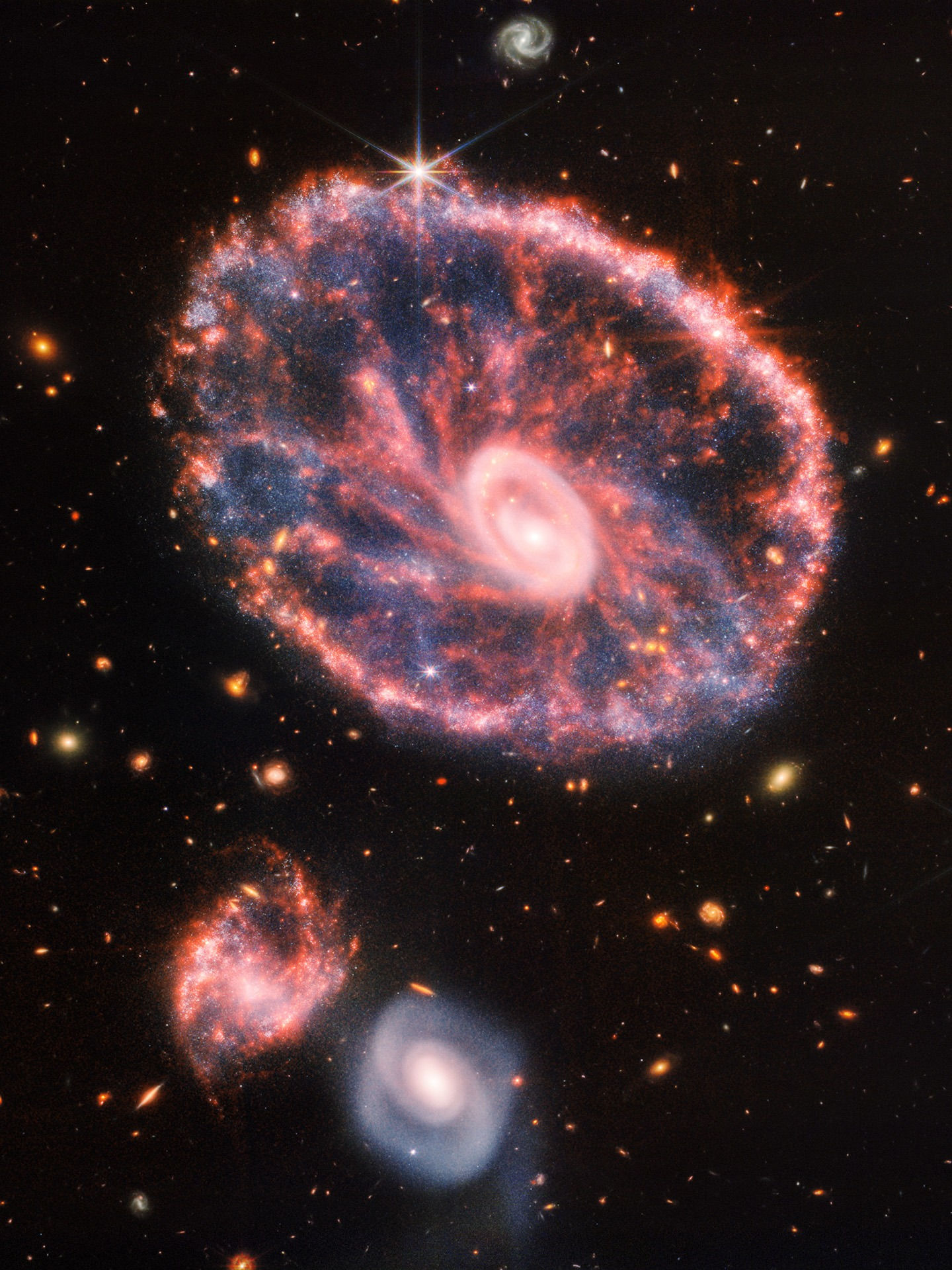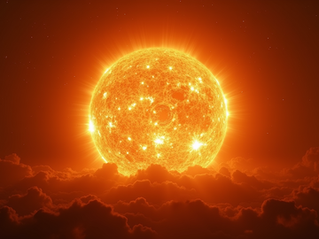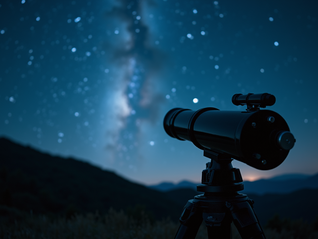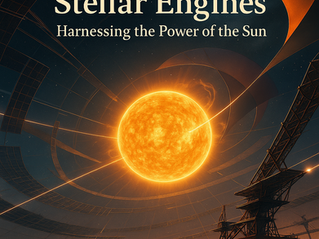The Ultimate Guide to Black Hole Theory
- Phystroid

- Feb 7, 2023
- 19 min read
Learn about the fascinating world of black holes and how scientists are unraveling their mysteries. Discover new insights and understanding with this comprehensive guide.
Black holes have long been a source of fascination and wonder in the scientific community. These mysterious celestial objects have captured the imagination of scientists and the general public alike, and continue to be the subject of much study and research.

Artistic impression of a black hole.
A black hole is the most dense object in the Universe, and is defined by the points inside the event horizon, or the point of no escape. Everything that passes inside the event horizon can still receive information from the outer world, however it can't send signals to the world outside the event horizon. Inside the event horizon gravity becomes strong enough, that traps even light itself.
Artistic impression of the drugging of spacetime around a black hole.
The theory of black holes is one of the most important and well-established theories in modern physics. It describes the formation, properties, and behavior of black holes and provides a foundation for our understanding of the universe.

A Kerr black hole is a rotating black hole solution to Einstein's field equations of general relativity. It is characterized by four main features:
Inner and Outer Horizons: The outer horizon and inner horizon in a black hole refer to the two null surfaces that define the boundary of the black hole's event horizon.
The outer horizon is the surface at which light can no longer escape the black hole's gravitational pull and is the boundary beyond which no signals can reach an observer.
The inner horizon, also known as the Cauchy horizon, is a boundary within the black hole where the laws of physics break down and where a theory of quantum gravity is needed to make predictions. The inner horizon is considered to be unstable and subject to fluctuations and is therefore sometimes referred to as the "point of no return".
In simple terms, the outer horizon marks the boundary of a black hole from which no light can escape and the inner horizon is the boundary within the black hole where the laws of physics become uncertain.
Singularity: This is a point in the center of a black hole where the laws of physics break down and the density of matter becomes infinite. In a Kerr black hole, the singularity is a ring-shaped region rather than a point.
Ergosphere: This is a region around a rotating black hole where objects can be forced to rotate along with the black hole due to its strong gravitational pull.
Penrose Process: This is a process by which energy can be extracted from a rotating black hole. It involves using the difference in rotational velocity between the ergosphere and infinity to convert some of the black hole's rotational energy into usable energy.
These features make the Kerr black hole a rich and complex object to study and understand.
Although there is no direct experimental evidence for the existence of the black holes, their existence can be inferred from their interaction with their environment. Many stars in our Galaxy, are members of a binary system, and if one of the two companions evolves into a black hole, it can accumulate around it materials from the companion star. These accretion disks are significant sources of x rays, and in many cases it is possible to calculate the mass and dimensions of the object in the center of the accretion disk. The only known object that can power systems like this is thought to be a black hole. Furthermore black holes have resisted any theoretical challenge until today, and they are solutions of Einstein Field Equations first discovered by Karl Schwarzschild in 1915 shortly after Einstein published his work. Kerr in 1963 found solutions describing rotating black holes.
For the more advanced readers who are interested in a detailed and well explained mathematical derivation of the black hole solutions from the general relativity, we recommend this book: https://www.phystro.com/product-page/general-relativity-from-the-hilbert-action
From a historical viewpoint, the first suggestions about the physical mechanism that can compress mass so much to create a black hole appeared in 1939, in a paper by Oppenheimer and Snyder: ”When all thermonuclear sources of energy are exhausted a sufficiently heavy star will collapse. Unless fission due to rotation, the radiation of mass, or the blowing off of mass by radiation, reduce the star’s mass to the order of that of the Sun, this contraction will continue indefinitely”. Today, this is recognised as the main mechanism for the generation of stellar mass black holes.

Artistic impression of a black hole.
In 1967 Werner Israel presented at King's College in London his "Uniqueness Theorem". This is also known as "No Hair Theorem" a phrase popularised by John Archibald Wheeler, and regarded offensive by Richard Feynman. According to which in the absence of angular momentum, gravitational collapse with sufficient mass will lead to a Schwarzschild black hole, irrespective of the shape of the collapsing star. A classical black hole can be described be only three parameters: Mass, Angular Momentum and Charge.
It is important to note that according to classical physics, there is no known physical mechanism that can prevent a strong enough gravitational field from compressing matter into a singularity. Of course this could signify that our current theories need to be modified in order to prevent such a singularity with infinite densities.

Artistic impression of the curved spacetime around a black hole. According to the general theory of relativity a black hole not only curves spacetime, but also drugs it faster than the speed of light.
Next, let's discuss further the different types of black holes:
Stellar black holes: These are the most common type of black holes and are formed from the gravitational collapse of massive stars. When a star large enough runs out of fuel and its core can no longer generate energy through nuclear fusion, it collapses under its own weight and forms a black hole. If the star is not massive enough, a neutron star or a white dwarf are formed. These objects are also extremely compact and interesting.
Neutron stars and white dwarfs are both compact objects that are formed from the remnants of stars. They differ in their sizes and densities.
Neutron stars are incredibly dense objects with a radius of about 10 km, making them only about 20 km in diameter. Despite their small size, they have a mass that is similar to the sun's, meaning their density is extremely high, with a single sugar-cube-sized amount of neutron-star material having a mass of about 100 million tons. Neutron stars are formed when a massive star explodes in a supernova, leaving behind a core that is so dense that it collapses into a ball of closely packed neutrons.
Such a neutron star is believed to reside inside the crab nebula. (Image below)
The crab nebula is located at the constellation of Taurus at a distance of 6500 light years from Earth. The image below depicts the core of the nebula, and you can see the ripples on the nebula that are created from the neutron star.

M1, or the crab nebula was the first nebula where a neutron star was observed. It is the remnant of a supernova explosion. This observation was made in 1967 and supported the idea that neutron stars and pulsars are the same. The pulsar at the center of the nebula is rotating 30 times per second!
White dwarfs, on the other hand, are less dense than neutron stars. They are about the size of the Earth, with a radius of about 0.01 times the sun's, meaning they have a diameter of about 6,000 km. Despite their much larger size compared to neutron stars, white dwarfs have a much lower mass, with a typical white dwarf having a mass of about 0.6 times the sun's. This lower mass combined with their larger size gives white dwarfs a lower density, with a single teaspoon of white-dwarf material having a mass of about 5 tons. White dwarfs are formed when smaller stars run out of fuel and their cores cool and contract, leaving behind a dense object made up of carbon and oxygen.
Below you can see a few amazingly looking planetary nebulae. This is believed to be the fate of our Sun, who has already lived for 5 billion years and has 5 more billion years of life. The Sun will first expand and transform into a Red Giant, and later into a planetary nebula and white dwarf.

Six different planetary nebulae
The size of a stellar black hole is proportional to the mass of the star that formed it, with the largest ones having masses of about 20 times that of the sun.
The formation of black holes, neutron stars, and white dwarfs is determined by the critical mass of the collapsing core of a star. The core of a star needs to have a certain amount of mass in order to form one of these remnants.
A core with a mass between about 1.4 to 3 times the mass of the sun will form a neutron star. This is because the core's mass is high enough to overcome the electron degeneracy pressure, which would otherwise prevent the core from collapsing further. The collapse creates a density so high that electrons and protons combine to form neutrons, hence the name neutron star.
If the core is more massive, between 3 to 5 times the mass of the sun, it will collapse to form a black hole. The intense gravity of the black hole prevents anything, including light, from escaping. The exact amount of mass needed for a black hole to form is still a subject of research.
On the other hand, if the core of a star has a mass less than 1.4 times the mass of the sun, it will not have enough mass to overcome electron degeneracy pressure, and will instead form a white dwarf. White dwarfs are extremely dense objects, but their size is similar to that of the Earth.
In conclusion, the critical mass for the formation of a black hole, neutron star, or white dwarf depends on several factors, including the size and composition of the star's core. However, generally, a core with a mass between 1.4 to 3 times the sun will form a neutron star, a core between 3 to 5 times the sun will form a black hole, and a core less than 1.4 times the sun will form a white dwarf.
In addition to that supernovae explosions will only create a black hole or a neutron star. White dwarfs are created inside planetary nebulae and with a significantly less violent process.

Artistic impression of a neutron star.
The matter inside a neutron star is so dense that electrons are squeezed into the atomic nuclei, resulting in a state of matter known as degenerate matter. This means that the electrons in a neutron star are so densely packed that they can no longer participate in chemical reactions and their distribution is determined by the Pauli exclusion principle. The result is a matter that is extremely dense and composed mostly of neutrons, hence the name "neutron star." In neutron stars, electrons and protons combine to form neutrons due to the extremely high densities and gravitational forces present. This process is called neutronization. As a result, the electrons are no longer free particles, but are instead combined with the protons in the atomic nuclei, forming neutrons. The formation of neutrons makes the neutron star extremely dense, with the entire star made up of densely packed neutrons.
The matter inside a white dwarf is also in a state of degenerate matter, but the electrons are not as densely packed as in neutron stars. The matter in a white dwarf is mostly composed of helium and carbon, and is held up against further gravitational collapse by the pressure generated by the degenerate electrons. These physical mechanisms of defence against gravitational collapse do not suffice though to hold a more massive stellar core from collapsing into a black hole.
Appart from stellar mass black holes two more types of black holes exist:
Intermediate black holes: As the name suggests, these black holes fall between the size of stellar and supermassive black holes. They are believed to be formed from the merging of several smaller black holes or from the collapse of a massive cloud of gas. Their existence has been inferred from observations of their gravitational effects on nearby stars and galaxies, but they have not yet been directly observed.

The merging of three galaxies. At the center of each galaxy a supermassive black hole resides. The merging of supermassive black holes is believed to be one of the most violent events in the Universe.
Supermassive black holes: These are the largest type of black holes and are found at the center of most galaxies, including our own Milky Way. They have masses that can range from millions to billions of times that of the sun. The exact mechanism for their formation is not yet fully understood, but it is believed that they may have formed from the merging of several intermediate black holes, or from the accretion of matter onto a central point in the early stages of galaxy formation.
In addition to the three main types of black holes, there is also speculation about the existence of hypothetical "mini" black holes. These black holes are thought to have formed in the early universe, shortly after the Big Bang, and would have masses much smaller than those of the other types of black holes.
Mini black holes are of interest to scientists because they could provide clues about the formation and evolution of the universe, as well as the properties of space-time itself. There have been various theories about the formation of mini black holes, including the possibility that they may have formed from fluctuations in the density of the early universe, or from the collision of cosmic strings.
Many people think that the life of a black hole is inversely proportional to its mass.
The size of the event horizon, or the boundary beyond which anything that enters cannot escape the gravitational pull of the black hole, is however what determines the life of a black hole. Larger black holes have larger event horizons and live for a longer time, while smaller black holes have smaller event horizons and have a shorter lifespan. The mass of the black hole is an important factor in determining the size of the event horizon, but other factors such as the spin of the black hole and the surrounding matter also play a role. Mini black holes would evaporate almost instantly if hawking radiation really exists.
Despite much speculation, there is currently no direct evidence for the existence of mini black holes. However, scientists continue to search for them using a variety of methods, such as looking for the gravitational lensing effect they would have on light from distant stars, or searching for high-energy particles that may be produced by their interactions with other objects in space.
Overall, while mini black holes remain a hypothetical concept at this point, they have the potential to provide important insights into the nature of black holes and the universe as a whole.
Black holes also have a number of interesting behaviors, including the emission of X-rays, gravitational lensing, and the production of jets. These behaviors are the result of the intense gravitational forces and the intense heating and radiation produced by the accretion disk. Here we will explain these three important aspects of black holes: gravitational lensing, jets, and accretion disks.
Gravitational Lensing
Gravitational lensing is a phenomenon that occurs when light from a distant object is bent by the gravitational field of a massive object. When a light source is located behind a massive object such as a black hole, the light will be bent in such a way that it forms a ring around the black hole, creating a unique and recognizable image. This effect is known as an "Einstein ring." Gravitational lensing can also create multiple images of the same object, which can be used to study both the black hole and the distant object. One of the most famous examples of gravitational lensing is the "Einstein Cross," which is a quasar that is lensed by a foreground galaxy. Another example is the galaxy cluster Abell 1689, which is known for its strong gravitational lensing of background galaxies.

In this Hubble Space Telescope image, the many red galaxies are members of the massive MACS J1149.6+2223 cluster, which creates distorted and highly magnified images of the galaxies behind it. A large cluster galaxy (centre of the box) has split the light from an exploding supernova in a magnified background galaxy into four yellow images (arrows) to form an Einstein cross. (Courtesy: Hubble Space Telescope)

Abel 1689, some of the faintest objects in this picture are probably more than 13 billion light-years away.
Jets
Jets are high-speed streams of particles that are expelled from the vicinity of a black hole. These jets can travel at velocities close to the speed of light and can reach lengths of many light-years. They are thought to be powered by the intense magnetic fields that are generated near the black hole. Jets are often observed in X-rays and radio waves and can provide important information about the behavior of black holes. One of the most well-known examples of jets is the radio galaxy M87, which has two massive jets that extend out from its center for over a million light-years. Another example is the quasar 3C 273, which has a bright jet that is visible in both radio and X-ray wavelengths.

The radio galaxy M87 at a distance of 53 million light years from Earth. The jet extends more than 1 million light years, that is 10 times the diameter of our Milky Way Galaxy.

3C 273 is one of the brightest and most distant quasars in the observable universe, located about 2.5 billion light-years away.
3C 273 is estimated to be over 1 trillion times more luminous than the Sun, emitting energy in the form of electromagnetic radiation across the entire spectrum, including radio, infrared, visible light, ultraviolet, X-rays, and gamma rays.
The intense radiation from 3C 273 is thought to be generated by a supermassive black hole at the center of the quasar, which is estimated to have a mass of about 2 billion times that of the Sun.
Quasars like 3C 273 are thought to be a crucial stage in the evolution of galaxies, providing the energy needed to ionize the neutral hydrogen gas in the early universe and triggering the formation of stars and galaxies.
The rapid variability observed in 3C 273 has challenged current models of quasar physics and has been used to study the structure of the accretion disk around the black hole, as well as the physical conditions in the surrounding gas and dust.
Despite its great distance, 3C 273 is one of the most studied astronomical objects and has provided important insights into the early universe, the evolution of galaxies, and the properties of black holes.
Accretion Disks
Accretion disks are disks of matter that are attracted to and eventually consumed by a black hole. As the matter in the disk gets closer to the black hole, it heats up and radiates energy in the form of light, X-rays, and other forms of radiation. Accretion disks are significant sources of energy and are an important aspect of black hole research. By studying the properties of accretion disks, scientists can learn about the behavior of black holes and the process of matter accretion. A well-known example of an accretion disk is the one surrounding the black hole in the binary system Cygnus X-1, which was the first black hole candidate to be identified and remains one of the best-studied examples of black hole accretion.

The fastest known black hole is a well known object: Cygnus X-1. Its rotational speed is close to the speed limit. It is a galactic X-ray source in the constellation Cygnus and it was the first candidate to be a black hole. Cygnus X-1 is close to a blue supergiant star and a stellar wind from the star provides material for an accretion disk around the X-ray source. It was discovered in 1964 during a rocket flight and is one of the strongest X-ray sources seen from Earth. This makes Cygnus X-1 the fastest known rotating object in the Universe!
You can read more about this here.

Artistic impression of hawking radiation.
Next, we will explain Hawking radiation, which we briefly mentioned in the context of mini black holes. Hawking radiation is a theoretical process that predicts that black holes can emit particles and radiation, leading to a slow decrease in mass over time. The idea is based on the principles of quantum mechanics and general relativity, which describe the behavior of matter and energy on very small and very large scales, respectively.
The basic idea is that particles can pop into existence in the vacuum of space-time near a black hole. If one of these particles has enough energy to escape the gravitational pull of the black hole, it will do so, carrying energy away from the black hole and causing it to lose mass. This process is known as Hawking radiation, and it was first proposed by physicist Stephen Hawking in 1974.
To understand the mathematics behind this process, it is helpful to consider the concept of virtual particles. In quantum mechanics, virtual particles are particles that appear spontaneously in the vacuum of space-time, but then disappear again just as quickly. These virtual particles can become real particles if they have enough energy, which can be calculated using the uncertainty principle of quantum mechanics.
In the case of a black hole, the uncertainty principle predicts that virtual particles can appear just outside the event horizon, the point of no return around a black hole. One of these virtual particles can be converted into a real particle that carries away energy and decreases the mass of the black hole. This process continues until the black hole reaches a certain size, at which point it is no longer able to produce Hawking radiation and it effectively stops losing mass.
For mini black holes, which are black holes with masses much smaller than those of typical black holes, the rate of Hawking radiation is much faster. This means that mini black holes would evaporate much more quickly than larger black holes, and could potentially disappear completely in a very short amount of time.
Gérard 't Hooft, a Nobel Prize-winning physicist, has expressed skepticism about the existence of Hawking radiation. He has argued that the process of black hole radiation is not yet well understood and that more research is needed to fully confirm its existence. 't Hooft has also discussed the possibility of alternative theories, such as the membrane paradigm, which challenges some of the assumptions made in Hawking's original derivation of black hole radiation. Overall, while Hawking radiation remains a fascinating area of research, its validity is still the subject of ongoing scientific debate and investigation.
In this article we are going to examine what would happen, if mini black holes could be created in the lab. Creating mini black holes in the laboratory is currently a theoretical concept and there is no proven method for doing so. Some theories propose that mini black holes could be created by colliding high-energy particles at incredibly high speeds, such as those produced by particle accelerators such as the Large Hadron Collider. These collisions would cause the particles to have enough energy to create a small region of extremely high density and gravity, which could potentially lead to the formation of a mini black hole.
For every object no matter how small there is a critical radius beyond which if it is compressed it will become a black hole. The so called Schwarzschild radius is the theoretical boundary around a massive object beyond which nothing, not even light, can escape its gravitational pull.
💡The Schwarzschild radius of the Earth is approximately 9 millimeters.
💡The Schwarzschild radius of the Sun is approximately 3.0 km.
Of course there is no known force that can compress the Sun or the Earth, to that point. However, this is not strictly true. If the Sun could collide with an other massive star it could form a black hole. Below, we will also examine a realistic scenario where we can convert the Earth into a black hole.
Of course, if Hawking radiation exists then this would only prove the theory, as the black holes would instantly evaporate. This would grant a Nobel Prize to Steven Hawking. However if Hawking radiation does not exist, as many famous physicists believe, then what would be the implications? Could such a tiny black hole continue to grow until it has devoured the whole planet?
The answer is positive. There is no known force that could stop such a black hole from first destroying the laboratory, and then continuing to eat everything at its vicinity until it has grown to the mass of the Earth. However, if we were to run a computer simulation what path would such a black hole follow? Would it be possible to move towards the center of the Earth? Since such a black hole would be attracted by the Earth's core in the same way that a brick is attracted, it would start to dive deep into the ground eating everything on its way, until it would reach the Earth's core. After that it would start to grow and the remains of the Earth would simply collapse into the black hole. This modelling assumes that the black hole doesn't have enough time to eat a significant part of the Earth while travelling to the center.
This raises the question about the rate that such a black hole would eat surrounding matter. However, matter would be gravitationally attracted a lot stronger by the Earth during the time that the black hole is still small in mass. Hence, the gravity of the Earth would dominate and the mini black hole would only eat the surrounding matter. The rate of mass accumulation by the black hole, would ultimately depend therefore on the speed of the black hole, since its initially gravity wouldn't be strong enough to attract far away matter.
Our Future, Startreck or not?
However this takes into account only the gravitational effects. In reality, we have seen that black holes form accretion disks that emit x - rays. This process would need to be taken into account when creating a computer simulation as the heat and the radiation would have an impact on what would happen on Earth. Some physicists have even suggested that this radiation pressure could even cause the Earth to explode, instead of collapsing.
However, in our opinion if a black hole existed at the center of the Earth, it would indeed have an accretion disk, which would emit high-energy radiation and particles. However, it is unlikely that the accretion disk and radiation emitted by a black hole at the Earth's center would cause the Earth to explode. Instead, the black hole's gravitational forces would likely cause the Earth to slowly collapse inward.
The conditions required for a planet or star to explode are highly specific and typically involve a balance of internal pressure and gravitational forces. In the case of a black hole at the Earth's center, the gravitational forces would dominate, leading to a slow collapse rather than an explosive event.
The timescale for a black hole to reach the Earth's core would depend on its initial size, mass, and velocity. In general, a black hole would move towards the center of the Earth due to its gravitational attraction, but its motion would not be a simple free fall.
As the black hole moves towards the Earth's center, it would encounter and accrete matter, causing it to grow in size and mass. The accretion of matter would also increase the black hole's gravitational pull, potentially leading to the formation of an accretion disk and the emission of high-energy radiation. These processes would cause the black hole's motion to deviate from a simple free fall and would also affect the surrounding matter, leading to complex and dynamic interactions.
Therefore all the videos that are currently available that claim to model such an event, are inaccurate, although it is reasonable to expect that the motion wouldn't deviate a lot from free fall given that the gravitational forces always dominate.
A hypothetical brick on the Earth's surface, would have to travel 6371 km, to reach the center of the Earth under free fall. This scenario assumes that the mass is concentrated at the center of the Earth though. In this scenario the brick would have to travel for 19 minutes to reach the center of the Earth. The formula used to find this is the following:
S=0.5 g (t^2)
Where S is the distance covered (6371 km) g is the gravitational constant (9.8m/s^2), and t is the time it takes for the brick to reach the Earth's core. In this case we have solved the equation for t to find the time of 19 minutes.
In addition to that, according to some highly speculative models of quantum gravity such as asymptotic safety the formation of extremely low mass black holes (that is Planck mass black holes) is prohibited due to the weakening of the gravitational coupling. This means that Newton's gravitational constant in these models is treated as a variable depending on the scale, and at low enough scales it becomes weak enough to prevent the formation of singularities.
To conclude, it is a long shot from the verified real existence of black holes, and the possibility of production of mini black holes in the lab, to the destruction of the Earth. However, we must be a lot more careful with our experiments, because unknown physics is there and instead of benefiting us it has the potential to destroy us.
The majority of scientific community, believes that such tiny black holes would evaporate using Hawking radiation, however if they are wrong as we believe then the consequences will be detrimental for the whole planet.
The study of black holes has led to many important discoveries in physics and astronomy, and has helped to shape our understanding of the universe. This includes our understanding of general relativity, the nature of time and space, and the evolution of stars and galaxies.
In conclusion, the theory of black holes is one of the most important and fascinating areas of modern physics. It provides a foundation for our understanding of the universe and continues to inspire new discoveries and exciting research. Whether you're a scientist or simply a space enthusiast, the ultimate guide to black hole theory is a must-read for anyone interested in exploring the mysteries of the universe.












































































































Comments